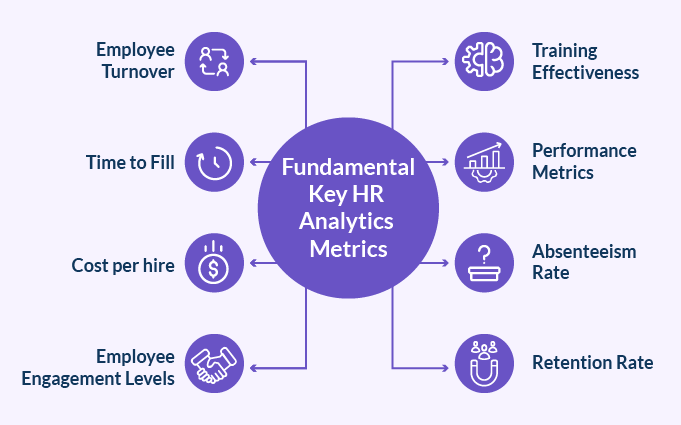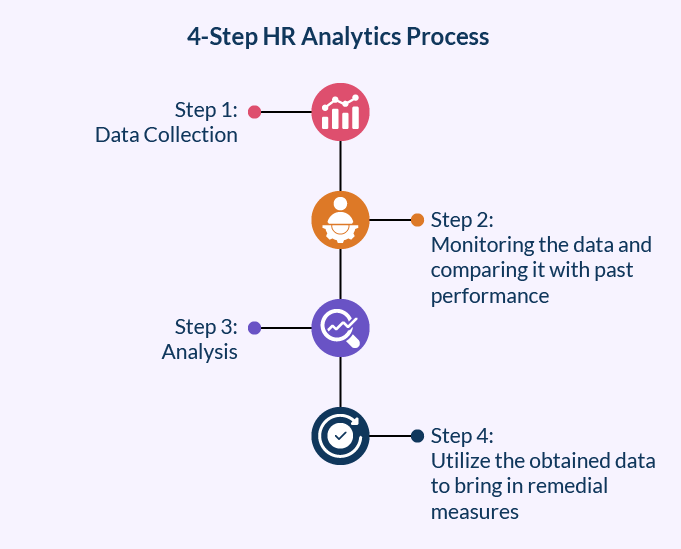HR Analytics: Meaning, Key metrics, Process, Examples, and Best Practices In 2024
In a world where data and algorithms are the emerging champions, HR analytics has taken the lead to capture the center stage. It delves into the complexities of the workforce while enabling HR leaders to solve the emerging puzzles.
Let us embark on a venture by diving into a world where numbers and trends have stories and insights to share, and your HR department becomes a narrator of employees’ career paths.
Key Takeaways
- What is HR Analytics
- Difference between HR Analytics and People Analytics
- What are the fundamental key HR Analytics metrics
- A detailed 4-step HR Analytics process
- Examples of HR Analytics
- What are the best practices and key objectives of HR Analytics
What is HR Analytics?
Human Resources Analytics, shortened to HR Analytics, is a detailed process that covers the collection, textual analysis, and interpretation of data relevant to the workforce of an organization.
The central goal of HR analytics is to utilize data-driven insights in initiating and implementing informed decisions about managing and optimizing the workforce.
The goal is to turn data into information, and information into insight.
– Carly Fiorina, Politician and Former CEO of HP
This practice assists in leveraging data from several HR systems and sources and delivers insights into different areas, such as recruitment, employee engagement, performance, retention, and overall HR strategy.
Difference between HR Analytics and People Analytics
It has also been noticed that many people use the terms HR analytics and people analytics interchangeably. Let us put an end to the misconception and clarify the differences between them.
| HR Analytics | People Analytics |
|---|---|
| Focuses on HR metrics and functions. | Covers a wide range of data, including HR metrics, and extends to broader business insights and workforce optimization. |
| The data and processes are HR-specific and within the HR department. | It expands beyond HR to cover cross-functional data from various departments. |
| Aims at optimizing HR processes and decision-making. | Aims to provide insights to drive strategic decisions across the entire organization. |
| Focuses on HR-specific metrics such as turnover rate, time to fill, training effectiveness, recruitment costs, etc. | Apart from HR metrics, it also focuses on employee engagement, productivity, workplace planning, financial impact, etc. |
8 Fundamental HR Analytics Metrics

Today’s competitive world demands a proper understanding of the importance of effective human resource management. Companies, in order to thrive and attain heights, must utilize the power of data-driven insights.
This is where the HR analytics metrics come into motion. These metrics are crucial indicators that show how effective these HR practices and strategic decisions are and how they contribute to the organization’s success.
Let us dive into those significant HR analytics metrics in the following section:
Employee Turnover
This metric sheds light on the number of employees that are leaving the organization. High employee turnover indicates issues that the employees undergo concerning workplace satisfaction, leadership, or company culture.
Time to Fill
The metric measures the average time taken to fill open job positions. The longer time for filling the positions can lead to productivity gaps and added pressure on existing employees.
Cost per Hire
It gives you an insight into the cost of hiring a new talent. By understanding the total cost of bringing in new talent, you will get an idea of optimizing recruitment budgets while equally maintaining the quality of hires.
Employee Engagement Levels
This metric gives insight into the employees' engagement levels that keep them committed and motivated at work. Higher engagement levels go hand in hand with increased productivity and retention.
Training Effectiveness
The metric is suitable to measure the impact the training programs create on employees’ skills and their subsequent performance. This factor is crucial in driving organizational growth and agility.
Performance Metrics
Role-specific performance metrics link an individual’s contributions to overall business objectives. This makes it simpler for you to align goals and identify core areas for improvement.
Absenteeism Rate
It tracks the rate at which employees miss out on their work. The absenteeism rate helps recognize patterns of employee absence, which can be related to either health or work-related issues.
Retention Rate
It shows the percentage of employees who stay with the organization for a certain period. A high retention rate shows how your organization keeps your employees satisfied and committed. This leads to stability in the workforce and a reduction in hiring costs.
These HR analytics metrics are more like diagnostic tools that help you get clarity on your workforce and address areas requiring attention and improvement.
4-Step HR Analytics Process

The HR analytics process comprises four primary steps that are performed one after the other. These steps form the bedrock of measuring the impact of HR initiatives while staying aligned with the metrics.
Let us get a detailed understanding of the processes below.
Step 1: Data Collection
Data are just summaries of thousands of stories – tell a few of those stories to help make the data meaningful
– Chip & Dan Heath, authors of Made to Stick
Collecting and categorizing high-quality data is HR analytics's first and most vital step. Basically, there are two categories of data required for the process. They are as follows:
Internal Data: Employee Tenure, Employee Training Records, Data on high and low performers, Retention, Engagement, Turnover, Salary and Promotion History, Absenteeism.
External Data: Organization-wide financial data, Passive data from employees right from the recruitment stage, Core offerings of the organization, and Historical data.
Step 2: Monitoring the Data and Comparing it with Past Performance
The second step is all about continuous assessment and comparison of the obtained data. At this step, the HR metrics are calculated to measure the effectiveness of the HR initiatives.
The HR metrics considered for the HR Analytics process are showcased below.
| Recruitment Metrics | Engagement & Retention Metrics | Time Tracking Metrics | Employee Value and Performance Metrics | Training and Development Metrics |
|---|---|---|---|---|
| Cost per Hire | Retention Rate | Absence Rate | Company Performance | Training Completion Rate |
| Time to Hire | Total Turnover Rate | Overtime Hours | Employee Performance | Training Expense per Employee |
| New-Hire Turnover | Voluntary Turnover Rate | Absence Rate per Manager | Revenue per Employee | Time to Completion |
| Headcount | Talent Turnover Rate | Goal Tracking | Training Effectiveness | |
| Demographics | Employee Satisfaction | Performance and Potential | ||
| Time to Productivity | Retention Rate per Manager |
Step 3: Analysis
After having assessed, compared, and calculated the HR metrics in the previous step, they can be analyzed further to identify the impact of HR initiatives and activities on the workforce.
The analytical methods commonly used in this process are as follows:
1. HR Descriptive Analytics
This particular type of HR analytics analyzes historical data to understand past happenings. The insights garnered from this analysis shed light on HR metrics such as turnover rates, employee engagement scores, recruitment scores, etc, and identifying trends and patterns. It helps HR professionals gain a clear picture of their workplace’s current scenario.
2. HR Diagnostic analytics
This form of HR analytics is oriented toward determining the cause behind the issues or problems. To be precise, it focuses on identifying the root causes of HR issues or trends. For instance, if your company has a high turnover rate, diagnostic analytics will come into play to determine the reasons or causes behind the high turnover rate. It might result from company policies, poor management, low satisfaction, or low compensation packages. Figuring out the accurate cause will help you make and deal with the necessary changes.
3. HR Predictive Analytics
This form of HR analytics uses statistical models and historical data to forecast workforce trends and outcomes. HR professionals can forecast future turnover rates or recruitment needs through predictive analytics. It helps organizations to be proactive and take action prior to the occurrence of the problems.
4. HR Prescriptive Analytics
This form of HR analytics involves using data to prescribe or recommend specific actions to reach a certain outcome. It is more focused on providing guidance on actions to be undertaken to achieve desired results. For instance, prescriptive analytics might suggest specific, actionable steps to reduce turnover or improve employee engagement if the company struggles with them.
Step 4: Utilize the Obtained Data to Bring in Remedial Measures
Once the HR metrics have undergone the analysis step, the analyzed data is further utilized to make informed decisions. The insights drawn from the analysis help address the issues that hamper the organizational processes and likewise implement remedial measures and improvements in the HR metrics.
By understanding and leveraging these different types of HR analytics, organizations can make more informed, data-driven decisions about their workforce.
Examples of HR Analytics
HR analytics strategy can help us gather a clear understanding of the type of data and insight that can be extracted from it. Several types of data points and survey analysis are provided by the HR analytics framework. Some examples of the framework are listed below. Let us dive through them.
As per an Economic Times article, a survey by SkyQuest found that Workforce analytics can significantly impact business outcomes.
1. 70% of Companies using HR analytics have a better understanding of their talent needs
2. 67% of companies can identify high potential candidates
3. North America is currently the largest workforce analytics market, covering a 35% share of the global market
HR Analytics Examples for Employee Engagement
-
Engagement Surveys: Engagement surveys are commonly used to measure engagement levels of an organization. HR analytics assists you in gathering and interpreting the data, identifying trends and patterns, and suggesting areas for improvement.
-
Pulse Surveys: Compared to engagement surveys, pulse surveys are brief and conducted rather frequently to measure employee feelings and engagement levels in real time. The data generated from these surveys gives faster insights into the impact of recent changes or initiatives.
-
Productivity Metrics: HR analytics can track productivity metrics such as output per hour and quality of work and asses engagement.
-
Employee Net Promoter Score (eNPS): The score indicates a measurement of the overall engagement. It determines how likely employees are willing to recommend their workplace to others.
-
Social Network Analysis: It involves analyzing an organization’s communication and collaboration networks within an organization.
-
Exit Interviews: Exit interviews can be one rich data source that can be analyzed to derive insights and reasons for employee disengagement and areas of improvement.
-
Performance Metrics Analysis: By comparing engagement survey results with performance metrics, you can better understand the relationship between engagement and performance.
HR Analytics Examples for Hiring & Recruiting
-
Quality of Hire: It evaluates the performance of new hires after a certain period. The data can be determined through factors such as job performance ratings, feedback from managers and peers, and turnover rates.
-
Source of hire: It keeps track of where the successful candidates come from, whether through social media or employee referrals. This can help refine recruitment marketing strategies.
-
Applicant Drop-off Rate: It analyzes the stage at which the applicants drop out of the process. It also helps HR identify and simultaneously fix issues haunting the recruitment process.
-
Candidate Experience: Collecting data on the candidates’ experiences during the recruitment process provides insights and helps improve the overall experience, thereby enhancing the employer’s brand.
-
Offer Acceptance Rate: This measures the rate at which the job offers are accepted. A low rate may result from salary issues, benefits, company culture, etc.
-
Skill Gap Analysis: Comparing the skills of successful employees with the applicants can help HR identify the gaps and modify the hiring criteria.
-
Employee Referral Rate: This form of analytics can help determine the number of candidates coming from employee referrals.
HR Analytics Best Practices
In the arena of HR analytics, success relies on following the best practices. These practices not only optimize HR processes but simultaneously elevate the organization.

The following section will explore the significant best practices that can aid HR analytics to unlock its full potential.
Without big data analytics, companies are blind and deaf, wandering out onto the web like deer on a freeway
– Geoffrey Moore, author and consultant
1. Ensure Data Quality
Insights can only be helpful when the data is authentic. Hence, to derive worthy insights through HR analytics, it becomes crucial for you to ensure that your data is accurate, complete, and consistent. The stronger the data, the more authentic your analytics and insights. The practice involves regular data cleaning and validation processes.
2. Invest in the Right Tools and Technology
Many HR analytics tools are available in the market today. A handful of them are listed below:
-
Workday
-
Bamboo HR
-
Talentsoft
-
Tableau
-
Visier
-
PeopleSoft
Choose an HR analytics tool that suits your organization's needs and budget. Opt for the one that harmoniously integrates with your existing systems, provides real-time analytics, and has user-friendly interfaces.
3. Build a Data-Driven Culture
The success of HR analytics lies in fostering a culture that values data and analytics. As HR professionals, you must embrace and promote data literacy and drive data-oriented decision-making. This commitment to data excellence will transform HR and empower organizations to thrive in the data-driven future.
4. Prioritize Data Privacy
With the increasing use of data comes huge responsibility. Since HR analytics heavily relies on data, it becomes important to prioritize data privacy and security standards. This involves complying with data protection regulations, obtaining secure permissions for collecting personal data, and ensuring that data is stored and used vigilantly.
5. Develop HR Analytics Skills
You must be equipped with essential data analysis and interpretation skills. Investing in training and development opportunities will empower you to take charge of HR analytics effectively. HR analytics requires a certain level of skill in data analysis and interpretation. You must develop these skills by undertaking opportunities for training and development.
6. Start Small and Scale Up
If you're new to HR analytics, start off with a manageable project or focus on a specific area of HR. As you steadily gain confidence and demonstrate the value of HR analytics, your efforts will shine higher, creating a greater impact.
7. Align with Business Objectives
Ensure that your HR analytics efforts are aligned with your organization's overall business objectives. Directing your efforts towards areas with greater business potential and impact will help you maximize the true value of HR analytics.
10 Key Objectives of HR Analytics
Like every other process, HR analytics is also driven by objectives. These objectives reflect the goals that organizations attain by putting HR analytics into action. Let us have a look at the 10 key objectives in the section below.
Measuring the impact of HR on bottom-line performance is the Holy grail of HR Analytics.
– Edward Lawler & John Boudreau
-
Improving workforce performance through data-driven insights.
-
Enhancing employee engagement by understanding key drivers.
-
Optimizing HR processes for efficiency and effectiveness.
-
Predicting and managing employee turnover.
-
Guiding strategic decision-making with reliable data.
-
Measuring the impact of HR initiatives and interventions.
-
Fostering a data-driven culture within the organization.
-
Aligning HR strategies with overall business objectives.
-
Identifying and developing talent through predictive analysis.
-
Improving recruitment strategies by analyzing hiring data.
Final Words
By now, you must have gathered a sound understanding of HR analytics and its significance in your organization. HR analytics is more like a compass that helps you navigate HR practices that align with the organization’s goals.
The data used in the process empowers organizations to make strategic decisions, unlock the potential of the workplace, and build a culture of continuous improvement.
As HR professionals, you need not rely on your gut feeling when the processes are more data-oriented. The results will outshine when the actionable steps are derived from proper data.


















